Megalodon sighting caught on Camera
| Megalodon | |
|---|---|
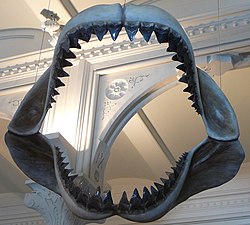 | |
| Model of megalodon jaws at the American Museum of Natural History | |
| Scientific classification | |
| Kingdom: | Animalia |
| Phylum: | Chordata |
| Class: | Chondrichthyes |
| Order: | Lamniformes |
| Family: | †Otodontidae |
| Genus: | †Carcharocles |
| Species: | †C. megalodon |
| Binomial name | |
| †Carcharocles megalodon | |
.
Naming
According to Renaissance accounts, gigantic triangular fossil teeth often found embedded in rocky formations were once believed to be the petrified tongues, or glossopetrae, of dragons and snakes. This interpretation was corrected in 1667 by Danish naturalist Nicolas Steno, who recognized them as shark teeth, and famously produced a depiction of a shark's head bearing such teeth. He described his findings in the book The Head of a Shark Dissected, which also contained an illustration of a megalodon tooth.[9][10][11]
Swiss naturalist Louis Agassiz gave this shark its initial scientific name, Carcharodon megalodon, in his 1843 work Recherches sur les poissons fossiles, based on tooth remains.[1][12] English paleontologist Edward Charlesworth in his 1837 paper used the name Carcharias megalodon, while citing Agassiz as the author, indicating that Agassiz described the species prior to 1843. English paleontologist Charles Davies Sherborn in 1928 listed an 1835 series of articles by Agassiz as the first scientific description of the shark.[13] The specific name megalodon translates to "big tooth", from Ancient Greek: μέγας, romanized: (mégas), lit. 'big, mighty' and ὀδούς (odoús), "tooth".[14][15] The teeth of megalodon are morphologically similar to those of the great white shark (Carcharodon carcharias), and on the basis of this observation, Agassiz assigned megalodon to the genus Carcharodon.[12] Though “megalodon” is an informal name for the shark, it is also often informally dubbed the "giant white shark",[16] the "megatooth shark", the "big tooth shark", or "Meg".[17]:4
There was one apparent description of the shark in 1881 classifying it as Selache manzonii
Evolution
| ||||||||||||||||||||||||
| Relationship between megalodon and other sharks, including the great white shark (Carcharodon carcharias)[19] |
While the earliest megalodon remains have been reported from the Late Oligocene, around 28 million years ago (mya),[20][21] there is disagreement as to when it appeared, with dates ranging to as young as 16 mya.[22] It has been thought that megalodon became extinct around the end of the Pliocene, about 2.6 mya;[22][23] claims of Pleistocene megalodon teeth, younger than 2.6 million years old, are considered unreliable.[23] A 2019 assessment moves the extinction date back to earlier in the Pliocene, 3.6 mya.[8]
Megalodon is now considered to be a member of the family Otodontidae, genus Carcharocles, as opposed to its previous classification into Lamnidae, genus Carcharodon.[22][23][24][25] Megalodon's classification into Carcharodon was due to dental similarity with the great white shark, but most authors currently believe that this is due to convergent evolution. In this model, the great white shark is more closely related to the extinct broad-toothed mako (Isurus hastalis) than to megalodon, as evidenced by more similar dentition in those two sharks; megalodon teeth have much finer serrations than great white shark teeth. The great white shark is more closely related to the mako shark (Isurus spp.), with a common ancestor around 4 mya.[12][19] Proponents of the former model, wherein megalodon and the great white shark are more closely related, argue that the differences between their dentition are minute and obscure.[26]:23–25
The genus Carcharocles currently contains four species: C. auriculatus, C. angustidens, C. chubutensis, and C. megalodon.[17]:30–31 The evolution of this lineage is characterized by the increase of serrations, the widening of the crown, the development of a more triangular shape, and the disappearance of the lateral cusps.[17]:28–31[27] The evolution in tooth morphology reflects a shift in predation tactics from a tearing-grasping bite to a cutting bite, likely reflecting a shift in prey choice from fish to cetaceans.[28] Lateral cusplets were finally lost in a gradual process that took roughly 12 million years during the transition between C. chubutensis and C. megalodon.[28] The genus was proposed by D. S. Jordan and H. Hannibal in 1923 to contain C. auriculatus. In the 1980s, megalodon was assigned to Carcharocles.[12][17]:30 Before this, in 1960, the genus Procarcharodon was erected by French ichthyologist Edgard Casier, which included those four sharks and was considered separate from the great white shark. It is now considered a junior synonym of Carcharocles.[17]:30 The genus Palaeocarcharodon was erected alongside Procarcharodon to represent the beginning of the lineage, and, in the model wherein megalodon and the great white shark are closely related, their last common ancestor. It is believed to be an evolutionary dead-end and unrelated to the Carcharocles sharks by authors who reject that model.[26]:70
Another model of the evolution of this genus, also proposed by Casier in 1960, is that the direct ancestor of the Carcharocles is the shark Otodus obliquus, which lived from the Paleocene through the Miocene epochs, 60 mya to 13 mya.[19][27] The genus Otodus is ultimately derived from Cretolamna, a shark from the Cretaceous period.[24][29] In this model, O. obliquus evolved into O. aksuaticus, which evolved into C. auriculatus, and then into C. angustidens, and then into C. chubutensis, and then finally into C. megalodon.
Another model of the evolution of Carcharocles, proposed in 2001 by paleontologist Michael Benton, is that the three other species are actually a single species of shark that gradually changed over time between the Paleocene and the Pliocene, making it a chronospecies.[17]:17[21][30] Some authors suggest that C. auriculatus, C. angustidens, and C. chubutensis should be classified as a single species in the genus Otodus, leaving C. megalodon the sole member of Carcharocles.[21][31]
The genus Carcharocles may be invalid, and the shark may actually belong in the genus Otodus, making it Otodus megalodon.[4] A 1974 study on Paleogene sharks by Henri Cappetta erected the subgenus Megaselachus, classifying the shark as Otodus (Megaselachus) megalodon, along with O. (M.) chubutensis. A 2006 review of Chondrichthyes elevated Megaselachus to genus, and classified the sharks as Megaselachus megalodon and M. chubutensis.[4] The discovery of fossils assigned to the genus Megalolamna in 2016 led to a re-evaluation of Otodus, which concluded that it is paraphyletic, that is, it consists of a last common ancestor but it does not include all of its descendants. The inclusion of the Carcharocles sharks in Otodus would make it monophyletic, with the sister clade being Megalolamna.[24]
Biology
Appearance
One interpretation on how megalodon appeared was that it was a robust-looking shark, and may have had a similar build to the great white shark. The jaws may have been blunter and wider than the great white, and the fins would have also been similar in shape, though thicker due to its size. It may have had a pig-eyed appearance, in that it had small, deep-set eyes.[26]:64–65
Another interpretation is that megalodon bore a similarity to the whale shark (Rhincodon typus) or the basking shark (Cetorhinus maximus). The tail fin would have been crescent-shaped, the anal fin and second dorsal fin would have been small, and there would have been a caudal keel present on either side of the tail fin (on the caudal peduncle). This build is common in other large aquatic animals, such as whales, tuna, and other sharks, in order to reduce drag while swimming. The head shape can vary between species as most of the drag-reducing adaptations are toward the tail-end of the animal.[17]:35–36
Since Carcharocles is derived from Otodus, and the two had teeth that bear a close similarity to those of the sand tiger shark (Carcharias taurus), megalodon may have had a build more similar to the sand tiger shark than to other sharks. This is unlikely since the sand tiger shark is a carangiform swimmer which requires faster movement of the tail for propulsion through the water than the great white shark, a thunniform swimmer.[17]:35–36[32]
Size
Average estimates
Due to fragmentary remains, there have been many contradictory size estimates for megalodon, as they can only be drawn from fossil teeth and vertebrae.[17]:87[33] Also because of this, the great white shark is the basis of its reconstruction and size estimation,[26]:57 as it is regarded as the best analogue to megalodon.[31] Using length estimates extrapolated from 544 teeth found throughout geological time and geography, including adults and juveniles, a 2015 study estimated an average length of 10.5 meters (34 ft).[22][25] In comparison, the maximum recorded size of the great white shark is 6.1 meters (20 ft), and the whale shark (the largest living fish) can reach 18.8 m (62 ft).[34][35][36][37] It is possible that different populations of megalodon around the globe had different body sizes and behaviors due to different ecological pressures.[25] In any event, it is thought to have been the largest macropredatory shark that ever lived.[38] A 2020 study—looking at the dimensions of the modern great white, mako, and Lamna sharks—suggested a 16 m (52 ft) megalodon would have had a 4.65 m (15.3 ft) long head, 1.41 m (4 ft 8 in) tall gill slits, a 1.62 m (5 ft 4 in) tall dorsal fin, 3.08 m (10 ft 1 in) long pectoral fins, and a 3.85 m (12 ft 8 in) tall tail fin.[39]
Mature male megalodon may have had a body mass of 12.6 to 33.9 metric tons (13.9 to 37.4 short tons), and mature females may have been 27.4 to 59.4 metric tons (30.2 to 65.5 short tons), assuming that males could range in length from 10.5 to 14.3 meters (34 to 47 ft) and females 13.3 to 17 meters (44 to 56 ft).[26]:61[7] A 2015 study linking shark size and typical swimming speed estimated that megalodon would have typically swum at 18 kilometers per hour (11 mph)–assuming that its body mass was typically 48 metric tons (53 short tons)–which is consistent with other aquatic creatures of its size, such as the fin whale (Balaenoptera physalus) which typically cruises at speeds of 14.5 to 21.5 km/h (9.0 to 13.4 mph).[40]
Its large size may have been due to climatic factors and the abundance of large prey items, and it may have also been influenced by the evolution of regional endothermy (mesothermy) which would have increased its metabolic rate and swimming speed. The otodontid sharks have been considered to have been ectotherms, so on that basis megalodon would have been ectothermic. However, the largest contemporary ectothermic sharks, such as the whale shark, are filter feeders, while lamnids are now known to be regional endotherms, implying some metabolic correlations with a predatory lifestyle. These considerations, as well as tooth oxygen isotopic data and the need for higher burst swimming speeds in macropredators of endothermic prey than ectothermy would allow, imply that otodontids, including megalodon, were probably regional endotherms.[41]
Maximum estimates
Gordon Hubbell from Gainesville, Florida, possesses an upper anterior megalodon tooth whose maximum height is 18.4 centimeters (7.25 in), one of the largest known tooth specimens from the shark.[42] In addition, a 2.7-by-3.4-meter (9 by 11 ft) megalodon jaw reconstruction developed by fossil hunter Vito Bertucci contains a tooth whose maximum height is reportedly over 18 centimeters (7 in).[43]
The first attempt to reconstruct the jaw of megalodon was made by Bashford Dean in 1909, displayed at the American Museum of Natural History. From the dimensions of this jaw reconstruction, it was hypothesized that megalodon could have approached 30 meters (98 ft) in length. Dean had overestimated the size of the cartilage on both jaws, causing it to be too tall.[44][45]
In 1973, John E. Randall, an ichthyologist, used the enamel height (the vertical distance of the blade from the base of the enamel portion of the tooth to its tip) to measure the length of the shark, yielding a maximum length of about 13 meters (43 ft).[46] However, tooth enamel height does not necessarily increase in proportion to the animal's total length.[26]:99
In 1994, marine biologists Patrick J. Schembri and Stephen Papson opined that C. megalodon may have approached a maximum of around 24 to 25 meters (79 to 82 ft) in total length.[47][48]
In 1996, shark researchers Michael D. Gottfried, Leonard Compagno, and S. Curtis Bowman proposed a linear relationship between a shark's total length and the height of the largest upper anterior tooth. The proposed relationship is: total length in meters = − (0.096) × [UA maximum height (mm)]-(0.22).[21][26]:60 They asserted that C. megalodon could have reached a maximum of 20.3 meters (67 ft) in total length.[7][26][49]
In 2002, shark researcher Clifford Jeremiah proposed that total length was proportional to the root width of an upper anterior tooth. He claimed that for every 1 centimeter (0.39 in) of root width, there are approximately 1.4 meters (4.6 ft) of shark length. Jeremiah pointed out that the jaw perimeter of a shark is directly proportional to its total length, with the width of the roots of the largest teeth being a tool for estimating jaw perimeter. The largest tooth in Jeremiah's possession had a root width of about 12 centimeters (4.7 in), which yielded 16.5 meters (54 ft) in total length.[17]:88
In 2002, paleontologist Kenshu Shimada of DePaul University proposed a linear relationship between tooth crown height and total length after conducting anatomical analysis of several specimens, allowing any sized tooth to be used. Shimada stated that the previously proposed methods were based on a less-reliable evaluation of the dental homology between megalodon and the great white shark, and that the growth rate between the crown and root is not isometric, which he considered in his model. Using this model, the upper anterior tooth possessed by Gottfried and colleagues corresponded to a total length of 15 meters (49 ft).[50] Among several specimens found in the Gatún Formation of Panama, one upper lateral tooth was used by other researchers to obtain a total length estimate of 17.9 meters (59 ft) using this method.[31][51]
In 2019, Shimada revisited the size of megalodon and discouraged using non-anterior teeth for estimations, noting that the exact position of isolated non-anterior teeth is difficult to identify. Shimada stated that the maximum total length estimates, based on upper anterior teeth that are available in museums, are 14.2 and 15.3 meters (47 and 50 ft), depending on the estimation method used.[52]
Teeth and bite force
The most common fossils of megalodon are its teeth. Diagnostic characteristics include a triangular shape, robust structure, large size, fine serrations, a lack of lateral denticles, and a visible V-shaped neck (where the root meets the crown).[26]:55[31] The tooth met the jaw at a steep angle, similar to the great white shark. The tooth was anchored by connective tissue fibers, and the roughness of the base may have added to mechanical strength.[53] The lingual side of the tooth, the part facing the tongue, was convex; and the labial side, the other side of the tooth, was slightly convex or flat. The anterior teeth were almost perpendicular to the jaw and symmetrical, whereas the posterior teeth were slanted and asymmetrical.[54]
Megalodon teeth can measure over 180 millimeters (7.1 in) in slant height (diagonal length) and are the largest of any known shark species,[17]:33 implying it was the largest of all macropredatory sharks.[38] In 1989, a nearly complete set of megalodon teeth was discovered in Saitama, Japan. Another nearly complete associated megalodon dentition was excavated from the Yorktown Formations in the United States, and served as the basis of a jaw reconstruction of megalodon at the National Museum of Natural History (USNM). Based on these discoveries, an artificial dental formula was put together for megalodon in 1996.[26]:55[55]
The dental formula of megalodon is: 2.1.7.43.0.8.4. As evident from the formula, megalodon had four kinds of teeth in its jaws: anterior, intermediate, lateral, and posterior. Megalodon's intermediate tooth technically appears to be an upper anterior and is termed as "A3" because it is fairly symmetrical and does not point mesially (side of the tooth toward the midline of the jaws where the left and right jaws meet). Megalodon had a very robust dentition,[26]:20–21 and had over 250 teeth in its jaws, spanning 5 rows.[17]:iv It is possible that large megalodon individuals had jaws spanning roughly 2 meters (6.6 ft) across.[17]:129 The teeth were also serrated, which would have improved efficiency in cutting through flesh or bone.[12][17]:1 The shark may have been able to open its mouth to a 75° angle, though a reconstruction at the USNM approximates a 100° angle.[26]:63
In 2008, a team of scientists led by S. Wroe conducted an experiment to determine the bite force of the great white shark, using a 2.5-meter (8.2 ft) long specimen, and then isometrically scaled the results for its maximum size and the conservative minimum and maximum body mass of megalodon. They placed the bite force of the latter between 108,514 to 182,201 newtons (24,395 to 40,960 lbf) in a posterior bite, compared to the 18,216 newtons (4,095 lbf) bite force for the largest confirmed great white shark, and 7,400 newtons (1,700 lbf) for the placoderm fish Dunkleosteus. In addition, Wroe and colleagues pointed out that sharks shake sideways while feeding, amplifying the force generated, which would probably have caused the total force experienced by prey to be higher than the estimate.[7][56]
Internal anatomy
Megalodon is represented in the fossil record by teeth, vertebral centra, and coprolites.[26]:57 As with all sharks, the skeleton of megalodon was formed of cartilage rather than bone; consequently most fossil specimens are poorly preserved.[57] To support its large dentition, the jaws of megalodon would have been more massive, stouter, and more strongly developed than those of the great white, which possesses a comparatively gracile dentition. Its chondrocranium, the cartilaginous skull, would have had a blockier and more robust appearance than that of the great white. Its fins were proportional to its larger size.[26]:64–65
Some fossil vertebrae have been found. The most notable example is a partially preserved vertebral column of a single specimen, excavated in the Antwerp Basin, Belgium, in 1926. It comprises 150 vertebral centra, with the centra ranging from 55 millimeters (2.2 in) to 155 millimeters (6 in) in diameter. The shark's vertebrae may have gotten much bigger, and scrutiny of the specimen revealed that it had a higher vertebral count than specimens of any known shark, possibly over 200 centra; only the great white approached it.[26]:63–65 Another partially preserved vertebral column of a megalodon was excavated from the Gram Formation in Denmark in 1983, which comprises 20 vertebral centra, with the centra ranging from 100 millimeters (4 in) to 230 millimeters (9 in) in diameter.[53]
The coprolite remains of megalodon are spiral-shaped, indicating that the shark may have had a spiral valve, a corkscrew-shaped portion of the lower intestines, similar to extant lamniform sharks. Miocene coprolite remains were discovered in Beaufort County, South Carolina, with one measuring 14 cm (5.5 in).[58]
Gottfried and colleagues reconstructed the entire skeleton of megalodon, which was later put on display at the Calvert Marine Museum in the United States and the Iziko South African Museum.[26]:56[27] This reconstruction is 11.3 meters (37 ft) long and represents a mature male,[26]:61 based on the ontogenetic changes a great white shark experiences over the course of its life
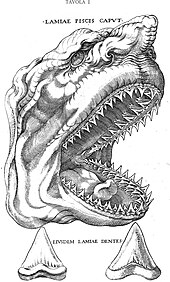
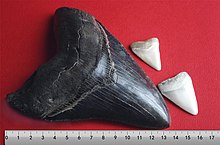
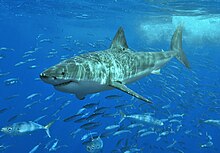

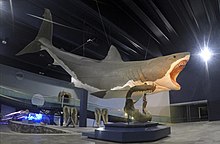




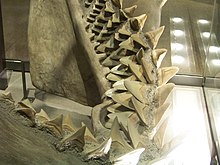

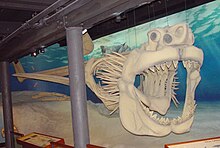



No comments:
Post a Comment
if you have any doubts.please let me know